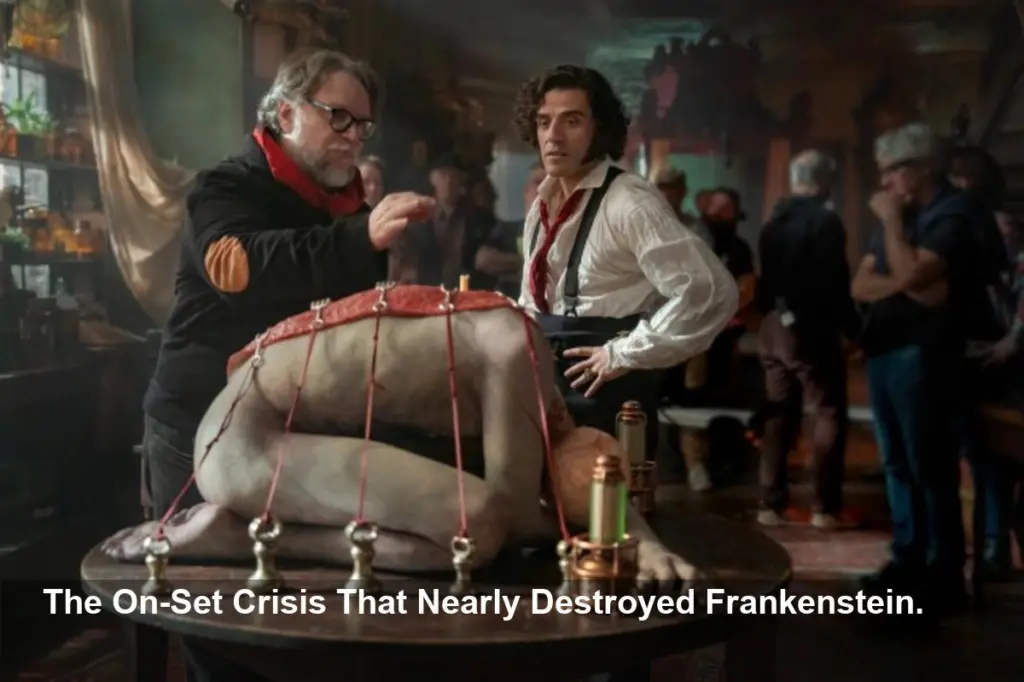Guillermo del Toro’s long-awaited “Frankenstein” is already earning significant Oscar buzz, but the film’s journey to the screen was nearly derailed by a production crisis that unfolded just weeks before cameras were set to roll.
- Casting Upheaval: Andrew Garfield, originally cast as the Monster, unexpectedly dropped out just nine weeks before filming began, forcing a frantic, last-minute search for a replacement.
- Complete Redesign: The creature’s extensive, custom-fitted prosthetics had to be completely scrapped and rebuilt from scratch to fit replacement actor Jacob Elordi.
- Elordi’s Transformation: Jacob Elordi had to rapidly gain weight for the role after becoming extremely thin for a previous part, a stark contrast to the hulking figure required for the Monster.
- Massive Practical Sets: The production, starring Oscar Isaac as Victor Frankenstein, relied on enormous, handcrafted sets, including a 130-foot ship and a multi-story laboratory, underscoring del Toro’s commitment to practical effects.
A Monster-Sized Problem
In a recent interview on the “Screen Talk” podcast, producer J. Miles Dale, an Oscar-winner for del Toro’s “The Shape of Water,” pulled back the curtain on the film’s biggest challenge. All the creature designs, including 42 sculpted pieces, were tailor-made for Andrew Garfield’s face and body. When scheduling conflicts forced him to exit, the team was left in a lurch.
Jacob Elordi’s Race Against Time
Enter Jacob Elordi. While eager to play the iconic creature, the 6-foot-6-inch actor presented a new set of challenges. He had just finished filming the series “The Narrow Road to the Deep North,” where he played a WWII prisoner and had lost a tremendous amount of weight. Dale revealed the immediate task for the new star was “to stuff his face with pizzas to be a big strong monster.” This dramatic physical transformation had to happen quickly, adding another layer of pressure to the already tight schedule.
Building a Grandiose Vision
The casting scramble was just one part of a monumentally ambitious production backed by a $120 million Netflix budget. Del Toro, a self-proclaimed “craft junkie,” insisted on minimizing CGI in favor of tangible, awe-inspiring sets to bring his decades-long passion project to life. This included building a 19th-century sailing ship, 130 feet long, in a studio parking lot and placing it on a giant gimbal to simulate the harsh seas.
The Laboratory of a Madman
The film’s other centerpiece was Dr. Frankenstein’s laboratory, an enormous water tower constructed from eight interconnected sets. The exterior alone took four months to build for just three days of shooting. This practical approach, according to Dale, is central to del Toro’s filmmaking philosophy, where production design, costumes, and cinematography work in perfect harmony.
Despite the hurdles, the film delivers a unique take that stays faithful to Mary Shelley’s novel by giving the creature a voice and his own point of view. “He does identify with monsters,” Dale said of del Toro. “He wanted to make sure to get the creature’s point of view. That’s unique about our film.”
Image Referance: https://www.indiewire.com/features/podcast/frankenstein-monster-jacob-elordi-1235157503/
